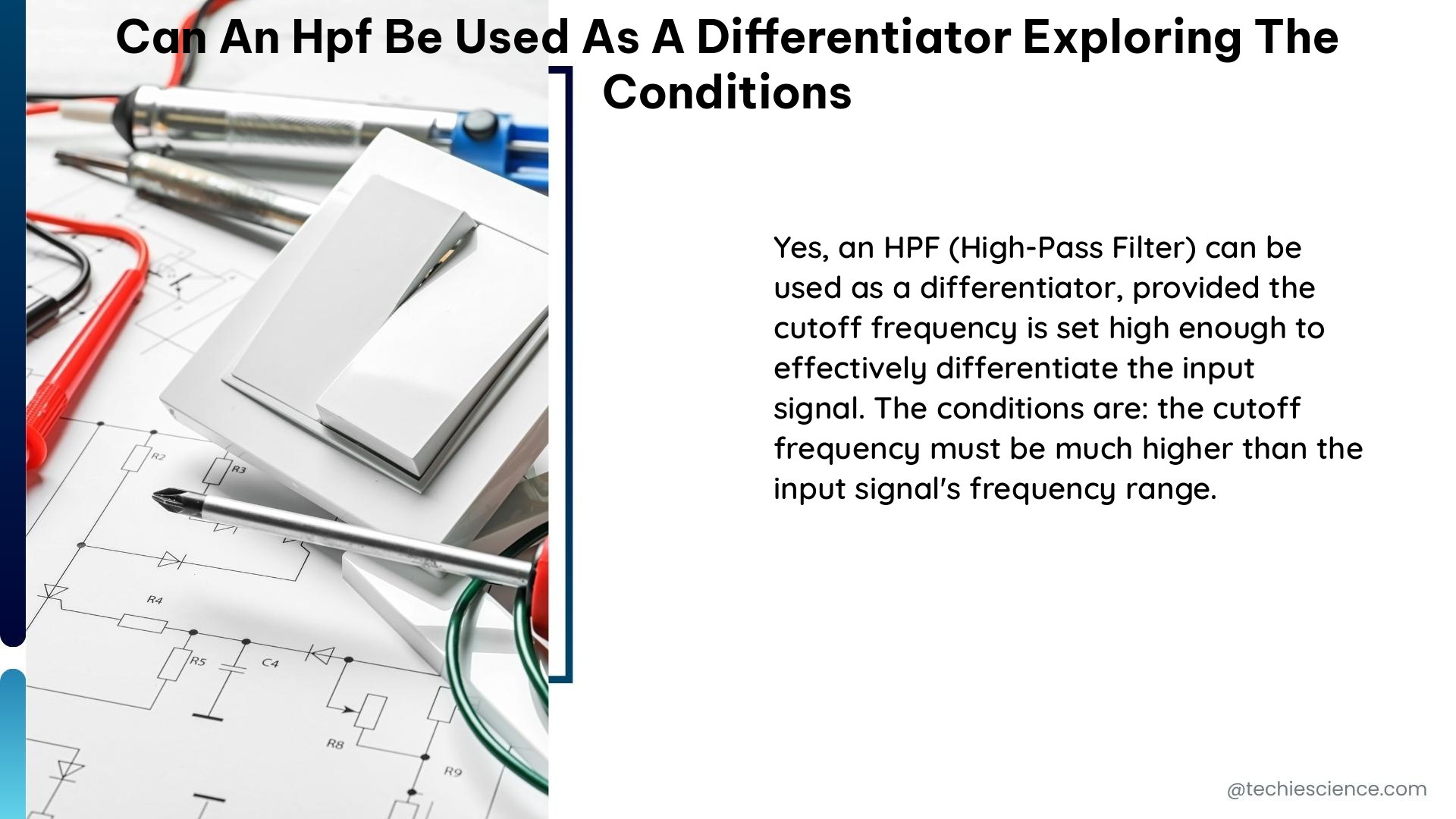An HPF (High Pass Filter) can be used as a differentiator under specific conditions. To understand this, we need to explore the conditions that allow an HPF to behave as a differentiator.
Condition for HPF to Behave as a Differentiator
The key condition for an HPF to function as a differentiator is that the time constant of the HPF must be much smaller than the time period of the input signal. Mathematically, this can be represented as:
$$\tau = RC \ll T$$
Where:
– $\tau$ is the time constant of the HPF circuit
– $R$ is the resistance
– $C$ is the capacitance
– $T$ is the time period of the input signal
When this condition is met, the voltage drop across the resistor in the HPF circuit becomes much smaller than the voltage drop across the capacitor. This allows us to simplify the equation for the output voltage of the HPF circuit as follows:
$$V_{0} = \tau \frac{dV_{i}}{dt}$$
Where:
– $V_{0}$ is the output voltage of the HPF circuit
– $V_{i}$ is the input voltage
– $\frac{dV_{i}}{dt}$ is the derivative of the input voltage with respect to time
This equation shows that the output voltage of the HPF circuit is proportional to the derivative of the input voltage. In other words, the HPF circuit behaves as a differentiator.
Frequency Response of HPF as a Differentiator

The frequency response of a practical HPF when it works as a differentiator is shown in the figure below:

The figure shows that the output amplitude of the HPF increases linearly with frequency, indicating that the HPF is behaving as a differentiator.
Output Waveform of HPF as a Differentiator
The output waveform of an HPF when it behaves as a differentiator depends on the input waveform. Here are a few examples:
- Sine Wave Input: If the input is a sine wave, the output will be a cosine wave.
- Square Wave Input: If the input is a square wave, the output waveform will change its shape and appear as shown in the figure below:

The figure shows that the output waveform of the HPF when it behaves as a differentiator has a different shape compared to the input square wave.
Practical Considerations
In a real-world scenario, there are a few practical considerations to keep in mind when using an HPF as a differentiator:
- Noise Sensitivity: The differentiator circuit is sensitive to noise, as it amplifies high-frequency components. This can be mitigated by using a low-pass filter at the output of the differentiator.
- Bandwidth Limitation: The bandwidth of the differentiator is limited by the time constant of the HPF circuit. To achieve a wider bandwidth, the time constant must be reduced, which may require the use of low-value resistors and capacitors.
- Stability: The differentiator circuit can be prone to instability, especially at high frequencies. Proper circuit design and component selection are crucial to ensure stable operation.
- Input Signal Amplitude: The input signal amplitude must be within the linear range of the differentiator circuit to avoid distortion or saturation.
Applications of HPF as a Differentiator
The use of an HPF as a differentiator finds applications in various electronic circuits and systems, such as:
- Edge Detection: The differentiator can be used to detect the edges of a waveform, which is useful in applications like pulse shaping, timing circuits, and signal processing.
- Vibration Analysis: The differentiator can be used to convert a displacement signal into a velocity signal, which is useful in vibration analysis and monitoring applications.
- Derivative Feedback: The differentiator can be used in feedback control systems to provide derivative feedback, which can improve the system’s stability and dynamic response.
- Analog Computing: The differentiator can be used as a building block in analog computing circuits, where it can perform mathematical operations like differentiation.
Conclusion
In summary, an HPF can be used as a differentiator under specific conditions. The key condition is that the time constant of the HPF must be much smaller than the time period of the input signal. When this condition is met, the output voltage of the HPF is proportional to the derivative of the input voltage, and the HPF behaves as a differentiator. The frequency response and output waveform of the HPF as a differentiator depend on the input waveform and the circuit design. Understanding the conditions and practical considerations is crucial when using an HPF as a differentiator in electronic circuits and systems.
References
- Electronics Tutorials – Passive High Pass Filter: https://www.electronics-tutorials.ws/filter/filter_3.html
- Tutorialspoint – Special Functions of LPF and HPF: https://www.tutorialspoint.com/electronic_circuits/electronic_circuits_special_functions_of_lpf_hpf.htm
- Electronics Tutorials – RC Differentiator Circuit: https://www.electronics-tutorials.ws/rc/rc-differentiator.html

The lambdageeks.com Core SME Team is a group of experienced subject matter experts from diverse scientific and technical fields including Physics, Chemistry, Technology,Electronics & Electrical Engineering, Automotive, Mechanical Engineering. Our team collaborates to create high-quality, well-researched articles on a wide range of science and technology topics for the lambdageeks.com website.
All Our Senior SME are having more than 7 Years of experience in the respective fields . They are either Working Industry Professionals or assocaited With different Universities. Refer Our Authors Page to get to know About our Core SMEs.